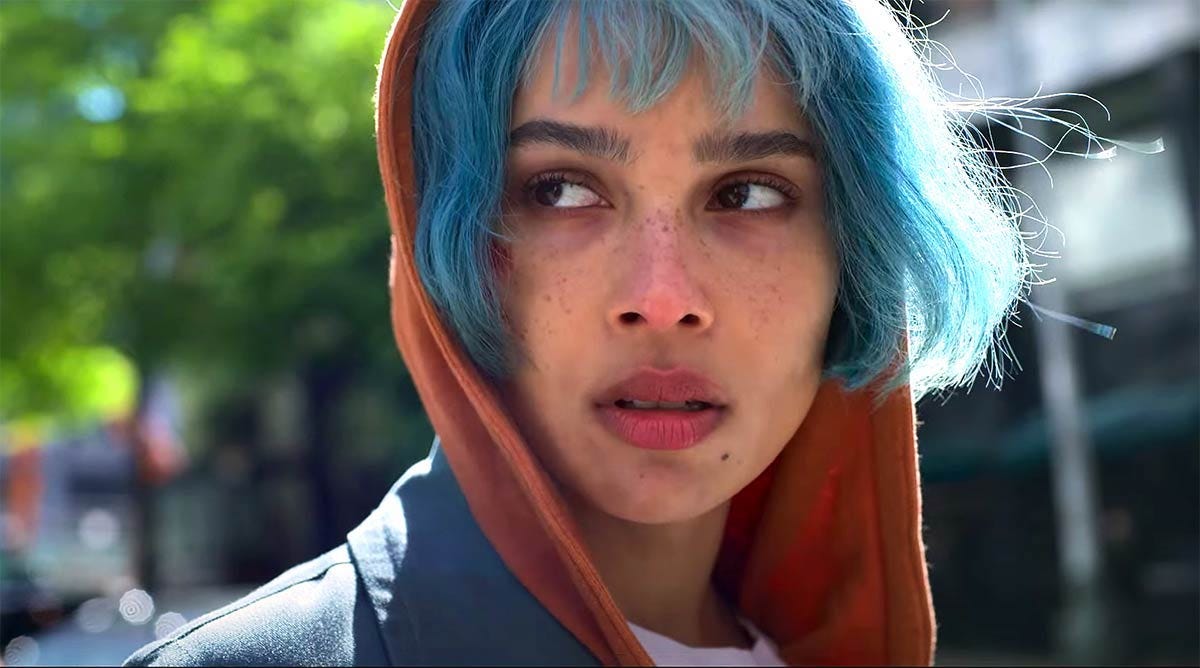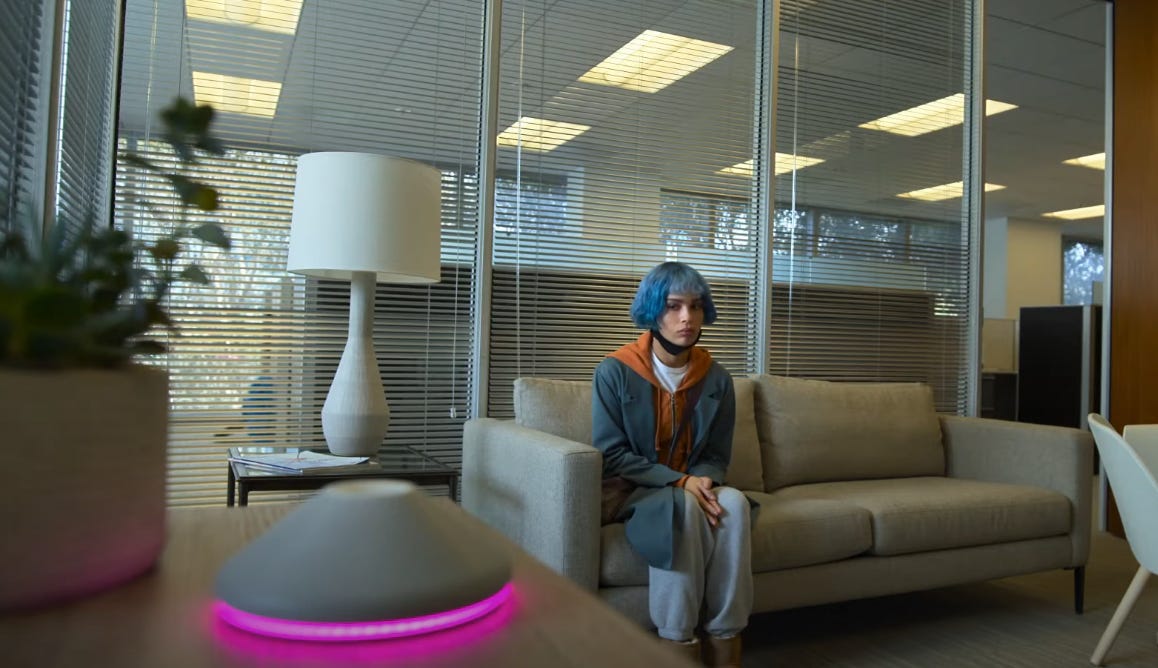Gimme "Kimi"
On HBO Max, another compact work of wit and craft from Steven Soderbergh.

The Nut Graf1: The latest made-for-streaming mousetrap from director Steven Soderbergh, “Kimi” (on HBO Max, ***1/2 out of ****) prompts an appreciation for one of the most underrated filmmakers currently working (and working).

Mark these words: In thirty years, graduate film students will be writing dissertations on the films of Steven Soderbergh, with a special focus on the director’s streaming years. This is to say that “Kimi,” on HBO Max, is very good – but so was last year’s “No Sudden Move” (HBO Max), and 2019’s “High Flying Bird” (Netflix), and, to a lesser degree, 2020’s “Let Them All Talk” (HBO Max), and 2019’s “The Laundromat” (Netflix). The first three especially are taut, tight, densely scripted, and performed by galleries of pros working deep in the pocket. They’re a reminder of how exhilarating a movie can be when it sets out to tell a story and tell it well.
“Kimi” stars Zoë Kravitz (“Big Little Lies”) as Angela Childs, a tech worker in a day-after-tomorrow Seattle that feels more like later today. She’s not Kimi – Kimi is the voice-activated virtual assistant that sits, Alexa-like, on Angela’s kitchen counter, chirping a cheery/creepy “I’m here!” whenever its name is called. Kimi is the product of a tech company called Amygdala, and Angela is one of Amygdala’s low-level drones. Her job as a “voice stream interpreter” is to listen to anonymized recordings of mistakes Kimi has made with home consumers – misunderstanding someone’s slang, for instance, or getting confused by a request to “play ‘Me’ by Taylor Swift” – and to adjust the software to correct for future requests. It’s numbing work but Angela doesn’t have to leave her apartment to do it, which is fine, since COVID and a trauma in her recent past that’s never fully explained have combined to turn her agoraphobic. She has a combative relationship with a tenant doing construction upstairs and a neighbors-with-benefits arrangement with a lonely cop (Byron Bowers) whose windows face hers, and that’s about it.
And then she hears something: A Kimi recording in which it sounds like a woman is being attacked. Maybe murdered. Angela has to play with filters and equalizers to isolate the voice from the background noise, and it’s in that long, eerie sequence of sonic exploration that you realize that “Kimi” is working in the same fields as Antonioni’s “Blow-Up” (1966), Coppola’s “The Conversation” (1974) and Brian De Palma’s “Blow Out” (1981) – movies in which horrific crimes can be glimpsed through the static of our all-pervasive media state. (Cliff Martinez’s score, meanwhile, leans hard on “Vertigo”-era Bernard Herrmann to atmospheric effect.)
The screenplay, by the gifted Hollywood journeyman David Koepp (“Jurassic Park,” “Carlito’s Way,” many others), plays this somewhat straighter than the Soderbergh norm, and with a reliance on coincidence that at times stretches belief. But the movie’s paranoia taps into our sneaking certainty that our gadgets are watching us, and the details are devilish – Angela’s harassed supervisor (Andy Daly) on Zoom, berating her for sending him the voice clip while screaming at his kids in the background; Darius (Alex Dobrenko), a flirty Romanian IT brat with keys to Amygdala’s back door; a mysterious Dr. Chowdhury (Rita Wilson), who needs Angela to come to the office right away. In the tense final act, “Kimi” becomes a chase film and then a highly satisfying variation on the “Wait Until Dark” home invasion thriller — and then it’s done and over in under 90 minutes, and you fall back on your couch to catch your breath.

I don’t want to oversell the thing, but neither do I want to understate the pleasures of a smart, compact, expertly crafted tale that understands what makes a good streaming movie different from one you’d see in a theater. “Kimi” is modest and small-scale, yet it hints at larger matters; it fits the dimensions of your TV or laptop — or, God forbid, your phone — while stoking anxiety about a world beyond our screens. (If the movie has a flaw, it’s that its conspiracy doesn’t feel quite big enough.) Almost all of this has to do with this director’s unfussy mastery of his medium(s). Soderbergh is 33 feature films into a 33-year career, which means he’s been averaging a movie a year ever since “sex, lies, and videotape” took off at the Sundance Film Festival in 1989. The only filmmaker with that level of productivity has been Woody Allen, and Soderbergh leaves Allen in the dust when it comes to consistency and quality control.
Not everything Soderbergh has done has been great or even good – “The Good German” (2006) was a coldly stylized attempt to update a 1945 Warner Brothers movie, and the experimental “Full Frontal” (2002) played dull shell games with its films within films. Other experiments, however, have reaped small but distinct rewards: The out-of-sequence “The Girlfriend Experience” (2009), the iPhone-filmed thriller “Unsane” (2018), the non-professionally cast murder mystery “Bubble” (2005). When he wants to tackle a big studio project, like the “Oceans Eleven” series or the Oscar-winning “Traffic” or the Elmore Leonard adaptation “Out of Sight” (1998) – arguably Soderbergh’s finest two hours – the results can be both delightful and profitable.

Still, it's in the middle area between the big blockbusters and the tiny whatsits that Soderbergh truly flourishes. “The Informant!” (2009) is a whistle-blower drama where the whistle-blower is a delusional idiot, and it’s the funniest thing Matt Damon has ever done. “The Limey” (1999) is an L.A. fever dream and revenger’s tale that resurrected Terence Stamp from the dead. “Contagion” (2011) is an oddly high-spirited virus movie; “Logan Lucky” (2017) a gut-funny racetrack heist flick. “Magic Mike” (2012) is the great male-stripper comedy the world didn’t know it needed.
Several things seem to drive this filmmaker: A technical or story-structure challenge, the chance to work with large and gifted casts, the minutiae of craft, the organic integrity of the production at hand. Soderbergh’s streaming-era films are audacious on one level – he’ll take HBO’s and Netflix’s money, thank you, and not care about a theatrical release – and works of unshowy, mature professionalism on the other. The best of his current run – the sports-agent morality play “High Flying Bird” on Netflix and the 1950’s auto-industry noir “No Sudden Move” on HBO Max – are rich with crosstalk and crisscrossing motivations; you need to lean in, maybe even turn on the subtitles to catch all the nuances. But they repay the effort through the absurdly enjoyable skill of the performances and an ethical compass that stays in the subtext, where it belongs. In the quantity and quality of his output – in the man’s sheer confidence – he may yet turn out to be his generation’s Howard Hawks: A filmmaker so complete he doesn’t need to talk about it.
If you enjoyed this edition of Ty Burr’s Watch List, please feel free to share it with friends.
If you’re not a paying subscriber and would like to sign up for additional postings and to join the discussions, here’s how:
If you’re already a paying subscriber, I thank you for your generous support.





